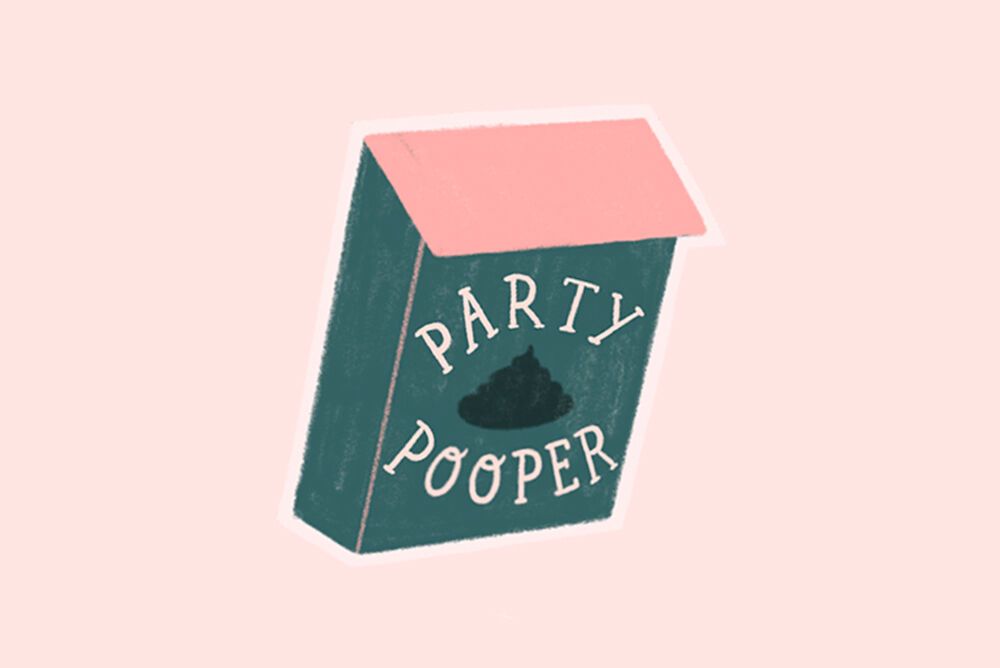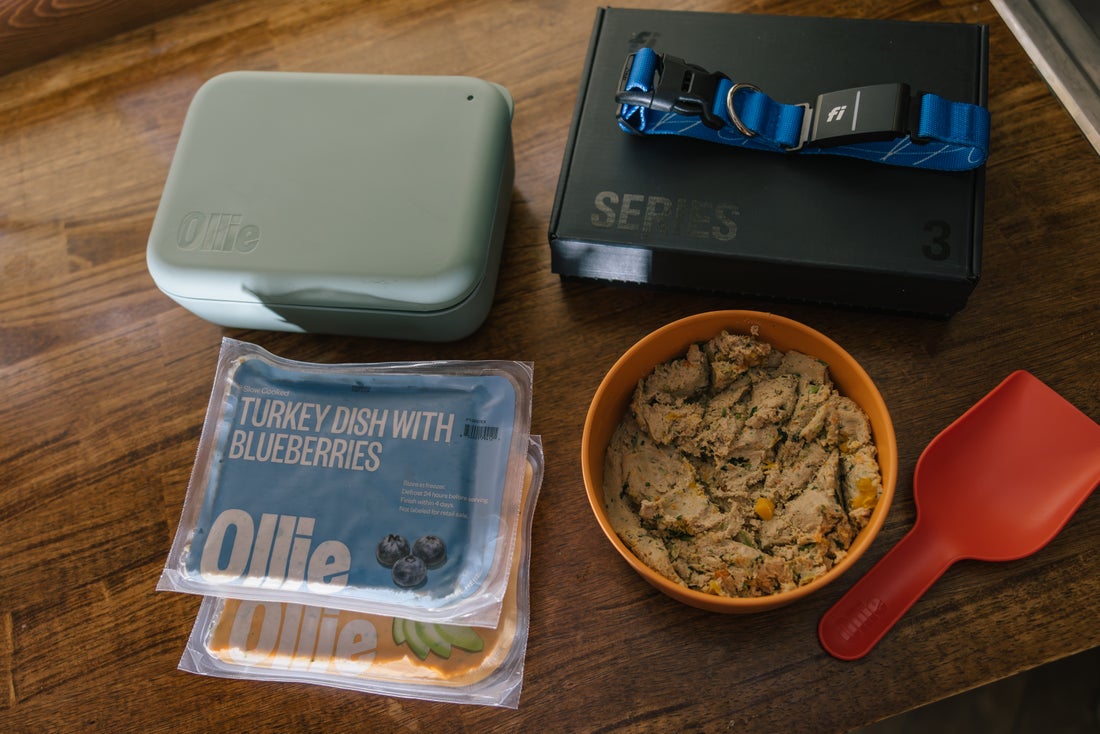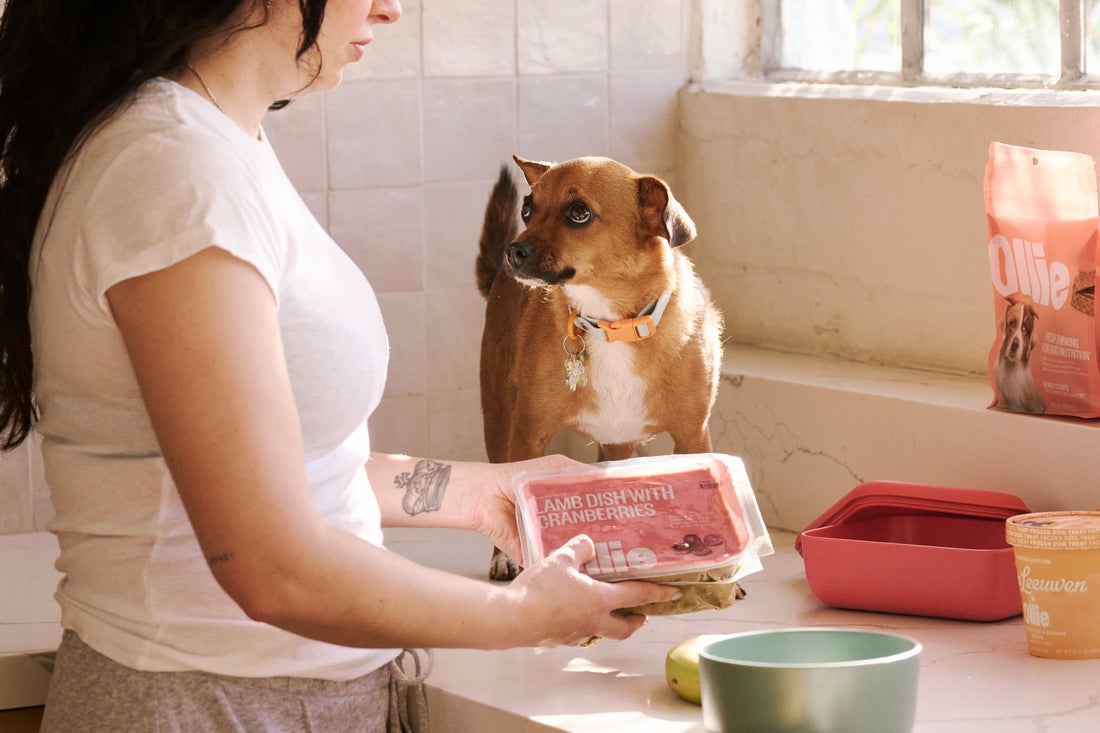Hey Ollie blog readers! We’re offering you an exclusive 60% OFF your starter box! Try now!
How to Understand Your Dog’s Poop
Although as a dog owner, you are likely extremely familiar with your dog’s poop, the next time you take your dog for a walk, take a good look at the stool before you discard the smelly mess. Your dog’s poop can provide important information about your canine companion’s health. Regularly observing your dog’s poop color, shape, consistency, size, and content can help you monitor your pup’s overall health and detect certain health complications. The following article is a comprehensive guide to help you understand your pup’s poop.
What Is a “Healthy Dog Poop”?
Before assessing your dog’s poop, learn what constitutes healthy canine excrement. The following categories describe an ideal pup poop1:
- Color — Your dog’s poop should be chocolate brown. If your canine companion eats food with added colors, you may see these in their stool.
- Shape — Your dog’s poop should be shaped like a log and should maintain its form.
- Consistency — Your dog’s poop should be compact, moist, and easy to pick up, and when squeezed, the stool should feel like molding clay.
- Size — The amount of poop your dog produces should be proportionate to the amount of food they eat. Your dog’s excrement amount increases if they eat a high-fiber diet.
- Content — The inside of your dog’s poop should look the same as the outside. Small undigested food bits aren’t cause for concern, but other items can indicate a problem.
Understanding Poop Color
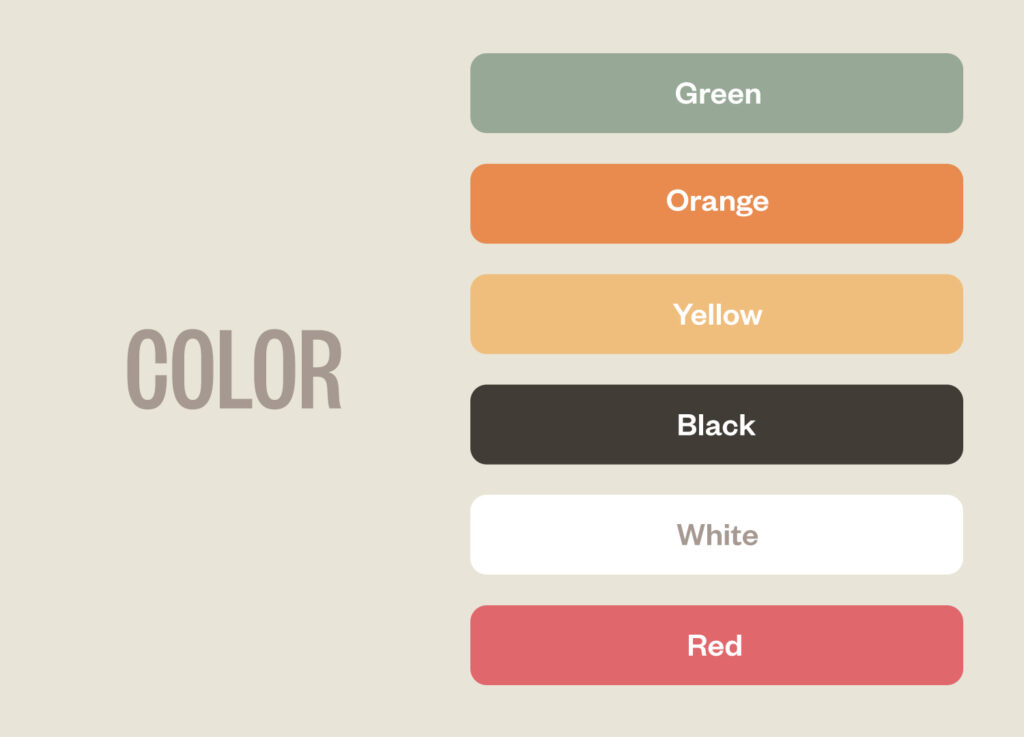
Normally, your dog’s poop should be light to dark brown. Ingredients in your canine companion’s food may cause minor stool color deviations, but substantial color changes can indicate a problem. Keep an eye out for these abnormal poop colors2:
Green — Green poop can indicate excessive grass consumption. While grass ingestion may seem like an innocuous issue, the behavior is often associated with anxiety or gastrointestinal (GI) upset. Another potential cause for green stool is gallbladder issues.
Orange or yellow — Orange or yellow poop can indicate your dog has a liver or pancreas problem. When these organs aren’t functioning appropriately, they excessively produce bilirubin, which stains your dog’s stool.
Black — Black poop may indicate that your dog’s upper GI tract is bleeding. Digested blood appears black in the stool.
White — White poop often indicates constipation and possibly a high-calcium diet. Dogs who eat a raw diet containing bones most commonly produce white stool.
Red — Red-streaked poop can indicate your dog’s lower GI tract is bleeding.
Understanding Poop Consistency
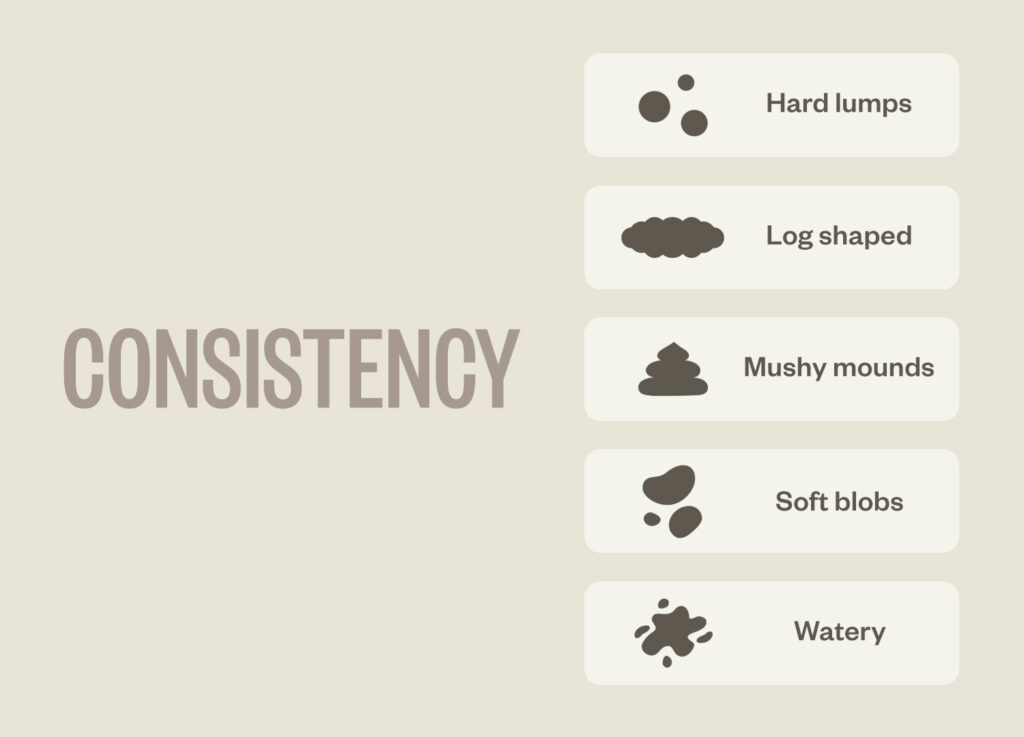
Your dog’s poop consistency is closely tied to their diet and overall health. Veterinarians often use a seven-point numerical scoring system to evaluate dog stool consistency, and a score of two to three is considered normal. Specific details for each score are as follows3:
1 — Extremely hard and dry, often expelled as individual dog poop pellets; may have hard balls or hard chunks in dog poop; requires much effort to expel; no residue is left on the ground when picked up
2 — Firm but pliable; segmented in appearance; little or no residue on the ground when picked up
3 — Log shaped with little or no visible segments; may present as sticky dog poop; leaves residue on ground but holds form when picked up
4 — Extremely moist and soggy; log shaped; leaves residue on ground and loses form when picked up
5 — Extremely moist but has a distinct shape; present in piles rather than logs; leaves residue on ground and loses form when picked up
6 — Has texture but no defined shape; present as piles or spots; leaves residue on ground when picked up
7 — Watery; no texture; present in flat puddles
Feeding your dog Ollie’s freshly cooked, human-grade dog food provides excellent moisture and nutrition to help your pup stay hydrated without causing diarrhea.
Understanding Poop Content
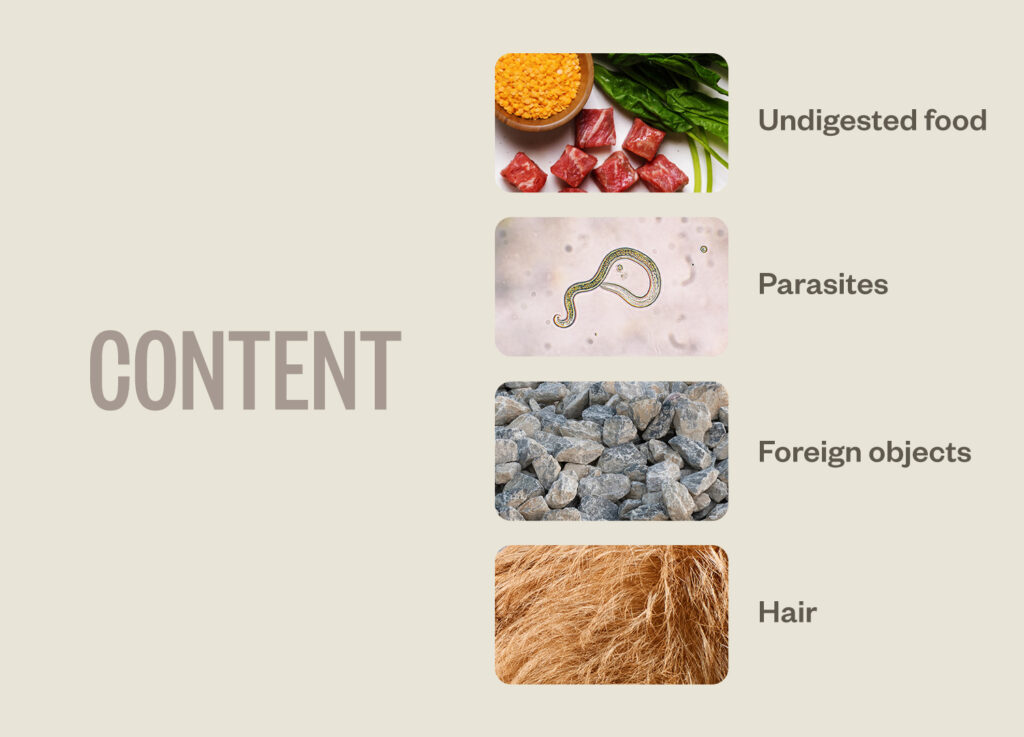
The content of your dog’s stool can help you determine whether they should have a veterinary exam. When looking at your pup’s poop, concerning content includes2:
Undigested food — Small undigested food bits can be normal. However, if undigested food is frequently visible, your dog may have a digestive problem, such as an accelerated intestinal transit time. This issue is typically associated with other signs such as vomiting or weight loss.
Parasites — While many parasites are microscopic—invisible to the naked eye—some are visible in your dog’s poop, including long, skinny roundworms, and rice-shaped tapeworm segments.
Foreign objects — Many dogs eat nonfood objects such as socks, rocks, and sticks. Large, hard white lumps in your dog’s poop may be undigested bone pieces. If your dog frequently ingests foreign objects, they could experience a GI obstruction, which typically requires surgical removal.
Hair — Large hair clumps in your dog’s poop can indicate overgrooming, behavior that is often secondary to conditions such as stress, allergies, skin disease, and boredom.
Other dog poop characteristics
A dog’s stool can tell you what they have been eating, and offers many clues to their health status. Your pup’s poop may have additional characteristics, including:
- Coating — Your dog’s poop should not have a coating. If your dog’s stool is covered in mucus, slime, or a jelly-like substance, they may have colitis, a large intestine irritation. Several issues, such as infection and inflammation, can cause this condition.
- Strong smell — Dog poop never smells pleasant, but if your dog’s poop is unusually malodorous, they may have a health issue. The easier your dog’s diet is for them to digest, the less stinky their poops. Provide your dog with a highly digestible diet, such as Ollie, which allows your pup to use the nutrients, producing less waste. Impending diarrhea may be another reason your dog is having excessively stinky stool.
Monitoring your pup’s poop can help you know how their GI tract is functioning and give you hints about their overall health status. Our Ollie diets are human-grade recipes that are balanced to meet your pup’s nutritional needs, keeping their poop habits healthy. The Ollie blog is devoted to helping pet parents lead healthier lives with their pups. If you want to learn more about our fresh, human-grade food, check out MyOllie.com.

Sources:
1. https://www.akc.org/expert-advice/health/dogs-poop-says-health/.
2.https://www.petmd.com/dog/care/how-should-my-dogs-poop-look.
3.https://www.amcny.org/pet_health_library/diarrhea-causes-and-treatments/.
The Ollie blog is devoted to helping pet parents lead healthier lives with their pups. If you want to learn more about our fresh, human-grade food, check out MyOllie.com.
Tagged As:

The nutrition your dog needs,
the food they want.

Enjoying our articles? Subscribe our Newsletters and get new articles directly to your inbox
You might also like
18 September 2025
5 MINS READ
Can I Rotate Fresh Dog Food Flavors?
Yes, it’s safe to rotate fresh dog food flavors, and many dogs actually benefit from the variety. At Ollie, we offer multiple fresh recipes, like Beef, Chicken, Turkey, Lamb, and Pork so you can…
by Ollie Pets
18 September 2025
5 MINS READ
Is Fresh Dog Food Safe During Power Outages?
Fresh dog food is only safe during a power outage if it has stayed cold, specifically, below 40°F. Once the temperature rises above that point, bacteria can start to grow, and the food may no lon…
by Ollie Pets
18 September 2025
5 MINS READ
How Do I Store Fresh Dog Food While Traveling?
If you’re bringing fresh dog food on the road, keeping it cold is key. The best way to store it is in a cooler with ice packs or a travel freezer. At Ollie, our vacuum-sealed fresh food stays good…
by Ollie Pets
